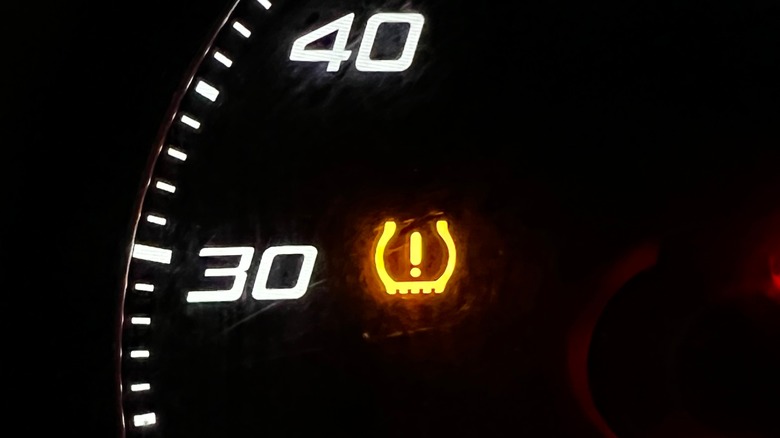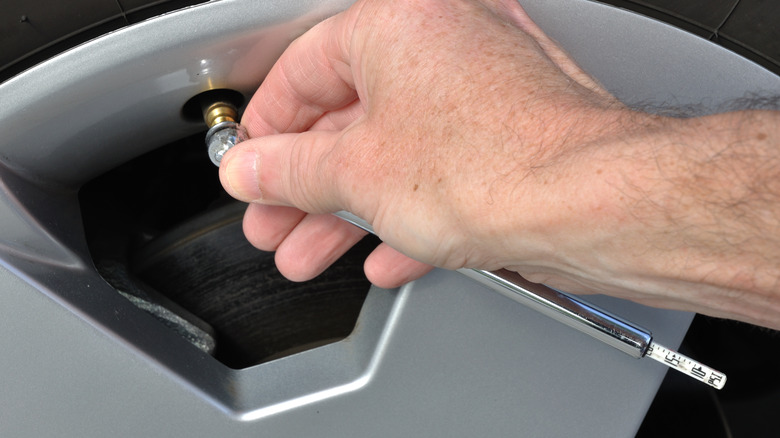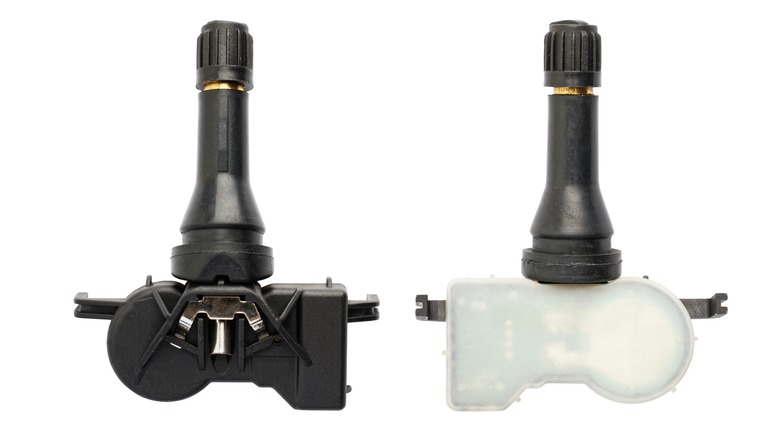What Your TPMS Light Means And What To Do About It
In the late-1990s, Firestone found itself in a heap of trouble over its defective tires, which were predominately installed on Ford's incredibly popular Explorer SUV. Eventually, over 6 million faulty tires were recalled, but not before causing hundreds of crashes and rollovers, some of which were deadly.
In the aftermath of this debacle, the U.S. Congress mandated that all passenger vehicles (under 10,000 pounds) must be equipped with a Tire Pressure Monitoring System (TPMS) to alert drivers of low tire pressure that could lead to hazardous driving conditions.
Should you panic when that little yellow tire symbol with an exclamation point on your dashboard illuminates? Not necessarily. The presence of the TPMS light does mean that one or more tires has low pressure, but all tires lose air gradually over time, so it could simply be too long since the vehicle's tire pressure was topped off. Then again, it could indicate something more sinister, like a puncture.
To make a diagnosis, drivers will need to own a tire pressure gauge, which should be stored inside the vehicle at all times. Basic units are approximately the size of a pen and only cost a few dollars at auto parts stores or big box retailers.
it could just be cold weather
The first step in troubleshooting the cause of a TPMS warning is to measure the air pressure in all of the vehicle's tires to determine which particular tire is or tires are low on air. The correct tire pressure can be found in the car's owner manual or more conveniently, on a sticker in the driver's door jamb area. Don't use the figure from the sidewall of the tire itself, because that's the maximum pressure rating for the tire, which may not be appropriate for all vehicles.
Once the offending tire has been identified, it can be refilled to proper pressure using a small portable air compressor or the air dispensing machines found at most gas stations.
If a tire's pressure is radically lower than the recommended pressure or the same tire repeatedly trips the TPMS light even after being filled, you might have a puncture or a leaking valve stem. Depending on the size and location of the leak, a tire store will most often be able to repair the tire. But in some cases, the tire may need to be replaced.
However, very cold temperatures can also trigger the TPMS warning light. It's said that for every 10 degrees Fahrenheit in outside air temperature, tire pressure will adjust by 1 psi. So tires filled to 30 psi at 80 degrees will read 25 psi at 30 degrees. The best prevention for this scenario is to check and fill the tires when temperatures begin to drop for the season, perhaps even very slightly overfilling to compensate for colder temperatures to come, but not by a lot.
What if the TPMS light is blinking?
If the TPMS light flashes for a period of 60 to 90 seconds after starting the vehicle, then turns solid, it means that the TPMS system itself needs service or repair, according to Tire Magazine. Typically, this is related to the TPMS sensors which are mounted inside the tires. These sensors are powered by a tiny battery, which can die. Since the sensor's battery can't be replaced, an entire new sensor is required.
Fortunately, the TPMS sensors aren't too expensive and have a lifespan of approximately five to seven years. Because the tire must be dismounted to replace the sensor, it makes financial sense to have all of the sensors replaced in conjunction with getting new tires, even if the old sensors aren't dead yet. Tire shops can typically replace individual sensors, if necessary, and will have a diagnostic tool to identify which sensors are faulty.
No driver likes to see warning lights on their car's dashboard, but maintaining proper tire pressure will make the tires last longer, improve fuel economy, and might even prevent an accident.


